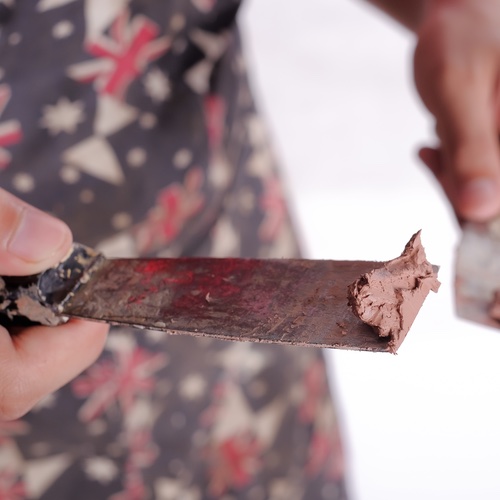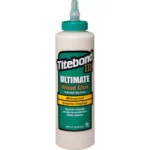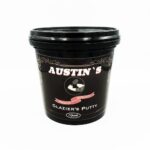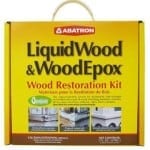
Having worked in the restorations trades for more than 20 years I have constantly been on the search for the best wood filler. I have tried countless products that at first seemed like a winner only to find, just like my high school dating experiences, they wouldn’t go the distance.
The conclusion I have come to is that there isn’t just one product, but rather a group of products that can handle any wood patching task I need. The best wood filler is sometimes not a wood filler at all, but a wood epoxy or even a putty. In this post, I’ll give you my take on the best products to patch wood on the market today.
The first thing you need to consider when choosing the best wood filler is what its use will be. Is it outdoors or indoors, painted or varnished, structural or cosmetic? There is a product for any need listed below, and you’ve just got to find the right one from the list below.
You can also read the results of my 5-year field testing of most of these wood fillers and epoxies at The Wood Filler & Epoxy Test (Year 5) to see how these products performed in the real world as well as to watch the video below.
MH Ready Patch
Best for small cosmetic repairs and surface leveling – MH Ready Patch is a great patch for a myriad of little patches. It doesn’t work for structural patches like an epoxy, but it does work quite well for things like nail holes and surface imperfections in painted wood (it’s not stainable). It dries fast, 30-45 mins and it’s ready to sand.
It is an oil-based product, but it cleans up with soap and water, which I love. I use it to fill holes smaller than a dime in size, smooth out alligatoring paint, surface checks, fill surface gouges or almost anything else I may need. Its only weakness is when you try to fill large areas which causes it to sag and shrink. Keep it limited to very small areas and always make sure you paint it because it will not last if left exposed to the elements.
LiquidWood & WoodEpox
Best for structural repairs or rebuilding of big portions of wood – There are tons of different types of epoxies for wood, but this product is by far my favorite because of its ease of use and long performance.
We use this every single day and my rot repair franchise Preservan uses a similar product by the truckload. The two parts work together to stabilize “punky” wood and fill in the missing areas.
The repairs can be sanded, drilled, planed, and essentially you are left with a repair that performs just like wood but will never rot or fall out. Epoxy repairs are some of the strongest, most long-lasting ways to patch wood. They are structural, so they can be used anywhere and are usually not troubled by water issues like other wood fillers.
Got some serious rot? This is the stuff you need. For info on how to use this awesome product, read my tutorial How To Repair Rotted Wood With Abatron Epoxy.
KwikWood
Best for small structural repairs in a hurry – Anyone who occasionally needs to patch wood should have a tube of this sitting in their shop or garage. This is a very simple to use 2-part epoxy that you mix with your hands. It’s kind of like squishing a tootsie roll together to mix both parts. Once you mix it, you have about 10 minutes before it starts to set up, and in 20-30 mins it is hard as a rock.
I use it to fill screw holes that have stripped out so I can get a sagging door hung again quickly or other tasks like that. Its fast drying time and resistance to rot and mildew make it perfect for exterior repairs too. I have used it outdoors and left it unpainted for years (not on purpose) with no problem.
Minwax Wood Filler
Best all-purpose wood filler – You knew I’d get around to an actual wood filler soon, right? Minwax Wood filler is such an easy to use and great product I am constantly surprised by how good it does for how little it costs. In the video above you can see the incredible results I got after a 5 year test with this stuff. It outperformed some epoxies and more expensive products big time.
It’s simple to apply with a finger tip or putty knife, sand when it’s smooth and prime when you’re done. No mixing to screw up. The fact that it’s not structural just means it should not be used for larger applications like the Abatron products above. It’s also a great option for stained and varnished projects as well as paint grade repairs.
Sawdust & Wood Glue

Best for color matching and flooring joints – This is a weird little trick that an old floor refinisher taught me and it really has worked great in very specific circumstances. Here’s how it works:
To patch wood using this method, you’ll need sawdust from the specific wood you are patching. Mix it with enough wood glue to get the consistency you need. You can make this a wet slurry and trowel it into the joints between old floor boards or make a thick paste to fill spots on damaged furniture.
You have to work fast enough that the glue doesn’t begin to dry on you, but to match the color of a repair for something that will be stained and varnished there is nothing better. Once it’s dry, sand the surface thoroughly and you’re good to go.
Austin’s Glazier’s Putty

Best for flexible joint filling – Glazing putty isn’t a wood filler, right? Wrong. For filling nail holes or joints glazing putty is actually incredibly useful.
Some glazing putties are bright white (DAP 33) which can hide well for painted trim, but are hard to see if you’ve gotten good coverage plus they can take weeks to cure. That’s why I created my own glazing putty with the help of the folks at Sarco Putty Co. that is usually ready for painting within just 24 hrs. It is also available in a brown color to blend in better for varnished projects.
For a better option to filling joints and ease of application you can’t beat a glazing putty. I can often use this in place of caulk for certain circumstances where more body is required than caulk which tends to sag.
What to Avoid
You’ll notice that there is one product I specifically did not include here that a lot of people use…Bondo. There is a good reason why it is not included in a post about the best wood filler and I’ve outlined why you should absolutely avoid Bondo when it comes to patching wood in this more in-depth post.
I’d love to hear what your experience has been with these products and if you have other favorites that you’ve found over the years. Are these truly the best products to patch wood or is there some other product that deserves the title of best wood filler.

Founder & Editor-in-Chief
I love old houses, working with my hands, and teaching others the excitment of doing it yourself! Everything is teachable if you only give it the chance.






Hi! I used the wood filler solution where my dog destroyed our door. However there are some shallows scratches I’d like to fill. The door is painted. Each time I fill them and then sand them they still show up. I’m probably sanding too much but don’t want the patch to be worse than the problem. How to you get the filler to stay in there so when you sand you get it flat and smooth with no scratch marks?
THANKS FOR ANY ADVICE! Am I just trying to get it too perfect?
You may be trying to attain too much perfection like all of us at times, but wood filler and sparkle tend to shrink as they dry so it may take over filling the area and then sanding it smooth. Always fill it a bit too much and sand off what you don’t need.
Hi Scott!
We have a puppy who has decided her favorite thing to chew is the corners of the cabinets. Since she is my dog, my husband has assigned me the task of fixing it. I am terrified of trying something and making it worse. Can you please give me some pointers on what sort of products to use and the procedure? My husband just told me to get some wood patch and seal.
Thanks so much!
Kilene
Kilene, follow the steps and try the products on this post about repairing rotted wood with epoxy. It is the same process you’d use for young puppy damage. They always seem to eat the good stuff don’t they? 😉
https://thecraftsmanblog.com/rotted-wood-repair-with-abatron-epoxy/
Dear Scott,
Thanks for your execellent article.I had two querries.I bought a second hand sheesham wood table which has a slight but long gap between the planks.What filler can I use.
The querry is that I want to oil it, which oil should i use and how should i prepare it before oiling.Just bit worried to whether to use a paint stripper or to sand it.
Thanks
Hey Scott,
I have kitchen cabinets that I removed the handles (2 screw holes) from and replaced with knobs (1 screw hole). In essence that left a quarter inch hole in each cabinet door. I read your blog but what is the “best” patch for that since the hole goes through and through. Our plan is to sand, prime and repaint the cabinets a new color. Thanks in advance!
Run, try either WoodEpox or KwikWood. They are the only thing I’d use for such a large hole that goes through and through. They sand smooth like a champ too!
Hi Scott, I’ve noticed some minor yet long cracks on my stairway. My stairway is covered with carpet but is opened below and that is where I have seen the cracks. What product do you recommend. Thank you for your response and your wonderful website.
Scott, I have an antique wood tool chest that was my great grandfather’s. It’s made of oak and pine. It was stained with a very dark color, and I’ve used stain remover and sanding to get it down to the wood as far as I can. I’ve repaired the damage with wood glue and putty. What is the best way to stain it? I want a light stain, but dark enough to blend in the remaining streaks of old dark stain I can’t get to.
Hi there. Sorry, there are just too many comments to look through for my answer, and I thought I would just ask you direct! I am new at staining wood and I am refinishing a coffee table made of pine. Everyone told me I could just use regular filler for the countless cracks, dings, holes etc but I was skeptical. Well, I varnished and it shows through! All that work! I put a 2nd coat on just to see if maybe I keep putting on more coats it will lesson, but it doesn’t seem to work. What should I do and which products do you recommend from above? Million thanks, Rebecca
Scott,
Just stumbled across your website on a Google search. I am refinishing a WWII Army luggage trunk and do not want to alter the appearance. However, it has lead-based paint, and rather than sand it I would prefer to use a paint stripper. The bottom also has chunks were the salt water took it’s toll on the piece. Can you think of any filler to place between the boards? I am just short of reconstructing a new floor panel to go below the damaged one. Also, do you know of any good paint strippers that will not further damage the antique wood?
I would appreciate any and all advise. Thank you,
Krys
Krys, Abatron WoodEpox and LiquidWood is perfect for this kind of repair. As for stripping paint try Citristrip. It is one of the best non-caustic paint strippers on the market.
Thank you! I will give these a shot. I will also bookmark this blog so I have a reference.
Hi Scott, help….we have made an indoor cedar sliding barn door and have four screw holes that we have to repair & fill. What would you recommend. Please and thank you.
G, try a tinted wood filler to match the cedar color. Should do the trick nicely.
thank you so much, we will try that. We appreciate your prompt reply.
Hi Scott! Our house has all wood trim and doors. My Dad leaned against my daughters closet door while reading to her. The door came off the track, fell and broke a large chunk of wood on the bottom of the door. The chunk is still partially attached. There is also another small piece of wood that completely off on the bottom of the door. Can you please give us suggestions to fix this. Thank you!
Hi and thanks for a great useful post. I have a question I am hoping you can help me with. My husband and I are making a dining room table from reclaimed wood. There are some bigger holes that don’t only go part way into the surface. Some are long and skinny and some are about the size of a quarter. We love the character they add to the table and want them to be visible. However, we are concerned about food etc getting trapped in them. Could we use an epoxy or something to fill the holes so they are a clear fill before we put wipe polyurethane finish on it? We want to keep the general feel and character of the wood as much as possible. Thanks so much!
Erika, I believe JB-Weld or Locktite makes an epoxy that is clear and can be used to fill these holes. Take a look and give it a try.
My dog has chewed into some of our door framing and our window sills. What product would be best used to fill those holes/gashes they’ve left? Previously i tried using putting that is used to fill drywall repairs, but it doesn’t seem to do the trick nicely. What would you recommend?
Aaron, if it is going to be repainted I would definitely use WoodEpox.
Hi Scott, our family dog enjoyed chewing and gouging our walnut stained baseboards and trim work. Now it’s time to try and fill in and repair. I tried the 6oz tube of Min-wax stainable wood filler and a can of dark walnut stain. Not happy with the outcome. The filler ended up looking grayish after 2 coats and my previously stained wood got much darker arounded the sanded areas. Kinda stands out like a sore thumb but better than a gouged hole. Any suggestions for my next 20 spots?. Thank you, Jerry
Jerry, there different colored woo fillers that might get you pretty close to the color you need. Also, the finer the sanding grit you use on the wood the less stain it will take so using something like a 220 or higher might keep the surrounding wood from getting too dark. It’s always a bit of an artist’s touch to fill and hide damage in varnished wood.
I need to reattach some legs to a bed. But the holes where the legs screw on are too big because the wood is worn. What is the best fix???? Please help!
Ivelisse, definitely KwikWood!
Great information, Scott. As a fine-art painter, I build my own picture frames. Unfortunately my carpentry skills don’t match my painting skills and THE MITERED EDGES OF THE FRAME DON’T ALWAYS MATCH UP PERFECTLY, LEAVING A GAP AT THE CORNERS. Wood filler and water putty don’t fill the cracks all that well; they seem to have their own cracking problems and leave a texture that doesn’t match the original wood. Final note: Sometimes I paint the frame but often I leave the wood bare. Thanks for your advice.
I am tranforming a crib into a bench for our anniversary. Once I take the crib apart, I know there will be some screw holes that I won’t want to see in the bench, best way to fix? Also, could you tell me the best way to sand down and weather prof without damaging the railings? They are carved.
Hi Scott,
It was a great pleasure to go through your site. I had spent the last couple of days trying to figure out the pros and cons to putty and found this the most comprehensive. I am looking for a putty that is quite elastic, and can withstand drastic warm and cold variations. Are epoxy’s better to use than putty fillers? What do you recommend?
Byron, epoxies will usually be a superior product in terms if adhesion and flexibility. They aren’t elastic, but they can move and flex better than standard putty when dry.
I am repairing a plywood deck that originally had a thin epoxy resin deck coating. Some of the plywood is badly damaged, and will be replaced completely. Other areas is structurally sound, but shows small grain gaps. I also have areas where the surface coat had weathered, and shows some fiber mesh tape joints. I’m looking for the proper filler before I go down with a good oil-based paint. I’ve read a lot of horror stories about the thick DeckOver and similar products, so I am leery of using them. I would rather repaint every five years than have to pull up the whole deck surface in two. From the discussions, it looks like Durham’s Wood Putty will be the best solution here – sounds like I can mix thin for the areas that need a leveler, and mix thicker for filling the cracks. Do you think this is the best for my situation? (Great blog, BTW!)
Tom, if you’re talking about an exterior deck then I would use Abatron because of the tough conditions. It can be thinned just like the water putty to whatever consistency you need.
Well, this is timely. I have part of an exterior mahogany sill that is rotted, and will remove it with a router. The rotted part will sit under a piece of trim, and I want to stain the sill with a weather-resistant finish when I’m done. Which filler should I use?
Abatron LiquidWood & WoodEpox all the way.
I have found a beautiful solid mahogany bookcase (not an antique) that has drill holes (about 4 total) scattered randomly on each side. I am going to paint it rather than try to refinish it, so am hoping you could suggest which of the products you mention above would be the best to use for this. Thanks so much!
Try Kwikwood, it sets up fast and dries very hard just like the mahogany.
How would u fix an see through knot hole on the insert of a stair with our replacing the entire stair